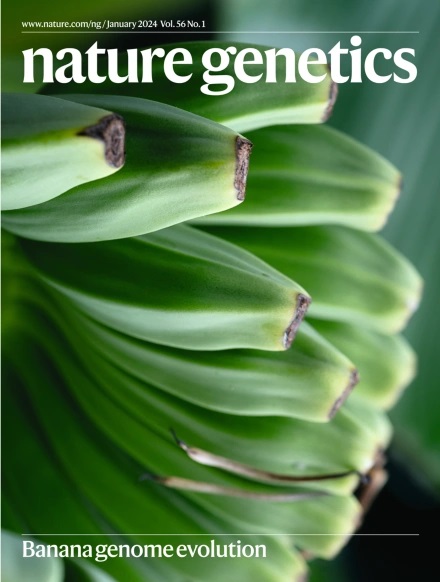An atypical NLR pair TdCNL1/TdCNL5 from wild emmer confers powdery mildew resistance in wheat
IF 29
1区 生物学
Q1 GENETICS & HEREDITY
引用次数: 0
Abstract
Resistance to wheat powdery mildew is commonly mediated by individual resistance proteins, most of which encode nucleotide-binding leucine-rich repeat (NLR) receptors. Here we report that the powdery mildew resistance gene MLIW170/PM26 in wild emmer and bread wheat derivatives is determined by a genetically linked atypical NLR pair TdCNL1/TdCNL5. Map-based cloning and PacBio HiFi long-read sequencing revealed that TdCNL1 encodes an atypical coiled-coil-domain-containing NLR protein (CNL) fused with a new potassium-dependent sodium-calcium exchanger integrated domain, whereas TdCNL5 encodes a canonical CNL protein. Mutagenesis and virus-induced gene silencing experiments indicated that both TdCNL1 and TdCNL5 are essential for powdery mildew resistance. Transgenic plants with TdCNL1 alone or TdCNL1/TdCNL5 together show resistance, whereas Fielder with TdCNL5 alone was susceptible. Geographically, MLIW170/PM26 occurs in a few Southern populations of wild emmer wheat. Our study highlights an atypical NLR pair coordinately regulating powdery mildew resistance and provides a diversified resistance gene resource for wheat improvement. The powdery mildew resistance of the MLIW170/PM26 locus, which originated from wild emmer wheat, is determined by a genetically linked atypical NLR gene pair, TdCNL1 and TdCNL5, with TdCNL1 encoding an atypical nucleotide-binding leucine-rich repeat protein integrating a potassium-dependent sodium-calcium exchanger domain.


来自野生二聚体的非典型NLR对TdCNL1/TdCNL5赋予小麦白粉病抗性
小麦对白粉病的抗性通常是由个体抗性蛋白介导的,其中大多数抗性蛋白编码核苷酸结合富亮氨酸重复(NLR)受体。本文报道了野生二粒小麦和面包小麦衍生物的抗白粉病基因MLIW170/PM26是由一个遗传连锁的非典型NLR对TdCNL1/TdCNL5决定的。基于图谱的克隆和PacBio HiFi长读测序显示,TdCNL1编码一个非典型的含卷曲-卷曲结构域的NLR蛋白(CNL),融合了一个新的钾依赖性钠钙交换器集成结构域,而TdCNL5编码一个典型的CNL蛋白。诱变和病毒诱导的基因沉默实验表明,TdCNL1和TdCNL5在白粉病抗性中都是必不可少的。单独携带TdCNL1或TdCNL1/TdCNL5的转基因植株表现出抗性,而单独携带TdCNL5的菲尔德则表现出抗性。在地理位置上,MLIW170/PM26出现在南方野生二粒小麦的少数群体中。本研究突出了一个非典型NLR对协同调控小麦白粉病抗性,为小麦改良提供了一个多样化的抗性基因资源。
本文章由计算机程序翻译,如有差异,请以英文原文为准。
求助全文
约1分钟内获得全文
求助全文
来源期刊

Nature genetics
生物-遗传学
CiteScore
43.00
自引率
2.60%
发文量
241
审稿时长
3 months
期刊介绍:
Nature Genetics publishes the very highest quality research in genetics. It encompasses genetic and functional genomic studies on human and plant traits and on other model organisms. Current emphasis is on the genetic basis for common and complex diseases and on the functional mechanism, architecture and evolution of gene networks, studied by experimental perturbation.
Integrative genetic topics comprise, but are not limited to:
-Genes in the pathology of human disease
-Molecular analysis of simple and complex genetic traits
-Cancer genetics
-Agricultural genomics
-Developmental genetics
-Regulatory variation in gene expression
-Strategies and technologies for extracting function from genomic data
-Pharmacological genomics
-Genome evolution
 求助内容:
求助内容: 应助结果提醒方式:
应助结果提醒方式:


